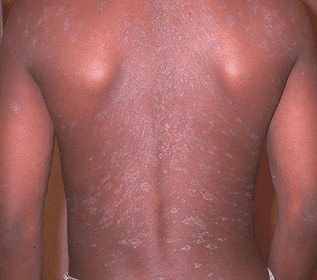
Dermatology Review
Quiz by NURS 517
Feel free to use or edit a copy
includes Teacher and Student dashboards
Measure skillsfrom any curriculum
Measure skills
from any curriculum
Tag the questions with any skills you have. Your dashboard will track each student's mastery of each skill.
With a free account, teachers can
- edit the questions
- save a copy for later
- start a class game
- automatically assign follow-up activities based on students’ scores
- assign as homework
- share a link with colleagues
- print as a bubble sheet
25 questions
Show answers
- Q1This benign rash is sometimes called the 'Christmas Tree Rash".Atopic dermatitisTina corporisPityriasis roseaEczema60s
- Q2This skin condition is caused by either strep or staph (or both!)VaricellaImpetigoHerpez zosterMRSA cellulitis60s
- Q3A collection of fluid-filled vesicles that present along a dermatome.MolluscumVaricellaUrticariaHerpes zoster60s
- Q4These smooth lumps can occur anywhere, & may be filled with semi-solid material.FuruncleAbcessSebaceous cystPustule60s
- Q5This rash on palms of hands or soles of feet is highly pruritic.SyphillisScabiesDyshydrotic eczemaHand-foot-mouth disease60s
- Q6One, or more, annular erythematous patches that heal leaving a hyperpigmented lesion.Fixed drug reactionBullaeErythema multiformeContact dermatitis60s
- Q7This raised scaly rash is typically circular, with central clearing.Granuloma annulareTinea corporisTinea versicolorPityriasis rosea60s
- Q8This is the antibiotic of choice for MRSA skin infections.Trimethoprim-Sulfamethaxole or ClindamycinCiprofloxacinCephalexinAmoxicillin clavulonate60s
- Q9Of the 6 classic childhood exanthems, this is the only one to be caused by bacteria.5th DiseaseMeaslesRoseolaScarlet fever20s
- Q10This contagious disease in young children presents as erythematous macules orally and on the distal extremities.MeaslesHand-Foot-Mouth DiseaseScabiesRoseola20s
- Q11Molluscum is differentiated from other papular lesions by its:Indented centersPearly colorSimilar sizesLimited distribution60s
- Q12These painless, warty growths may be found in the mouth, genitalia, or anus.Condyloma acuminatumHerpes Type 1Herpes Type 2Papilloma60s
- Q13This common contagious illness in children presents with a "slapped face" appearance.MeaslesPityriasis roseaFifth DiseaseRoseola60s
- Q14This rash may occur if a patient is inadvertently treated with Amoxicillin for what virus?HPVEpstein-Barr ("Mononucleosis")Varicella ("chicken pox")60s
- Q15The difference between a papule and a nodule is:Sensation! Papules are painless, nodules are painful.Size! Papules are less than 1 cm, nodules are larger than 1 cm.Color! Papules are always pink, nodules can be any color.Distribution! Papules are often clustered, while nodules occur as single lesions.20s
